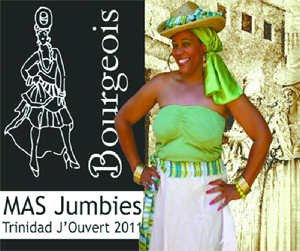Bourgeois hits the road in 18th-century style
Bourgeois, a 2011 J’Ouvert presentation, takes its main inspiration from the Carnivals held in Trinidad during the early 1800s (1783-1805).Carnival was brought to Trinidad by the French immigrants in the 1770s. Prior to that there was no account of Carnival being in existence.
Before the French arrival, Trinidad’s population was very small. After 1797 (British capture), however, it grew considerably, including a very large number of African slaves. Carnival in those times was exclusively enjoyed by society’s upper and middle classes, which meant the slaves were barred from this event. It was only after the emancipation of slavery in the British Colonies (1833) that slaves were legally allowed to participate.
According to Pierre Gustave Borde’s Historie de la Trinidad, the French planters were a true rural aristocracy and authorised to wear the sword of Louis XIV. As a very close knit group, the planters withheld their cultural standards and customs to the hilt, and Carnival was one of these. In those days Carnival would commence from Christmas and end on Ash Wednesday. This period was also marked by elaborate and lavish masked balls and the customary evening house visits in costume.
After the British capture, Carnivals continued with formal masked balls held by the British Governor Sir Ralph Woodford at Government House in St Ann’s.Although legally barred from Carnival, the slaves secretly partook in it during their day offs. Some of the talented ones were called to perform at the various masked balls. One account from 1826 tells that a slave called Ofuba the Chantwell was often called to perform the “neg deye potla,” while another called Jack Bowell, used to dance dress as a French Marionette.
During this time the slaves slowly began to influence the French Carnival with their African culture. This infusion culminated on the Emancipation of Slavery, and started a period known as the Jamet Carnivals. Many of the traditional masqueraders had their early roots here, like the infamous jab molassie, the dame lorraines, the chantwell and even the princely pierrot.
The band, produced under the banner of Mas Jumbies, will consist of seven costumed sections, modern in design and infused with early 18th century fashion aesthetics. It will be our most elaborate presentation to date to mark our fifth anniversary in the Trinidad J’Ouvert arena (2007-2011).
THE SECTIONS
1. Les Dames Vertes
2. Les Gentilshommes Verts
3. Les Dames de Bordeaux
4. Les Gentilshommes de Bordeaux
5. Les Femmes du Bourbo
6. Les Gentilshommes de Bourbon
7. Les Gentilshommes d’Orange
8. Negue Jardin (male & female)
9. Vive la France (male & female)
10. Les Demons de Melasse (male & female)
source
Search This Blog
Subscribe to:
Post Comments (Atom)
Share it.
Translate
ShareThis
Facebook Badge
MAS REPUBLIC Headlines

This is MassassinnatioN








No comments:
Post a Comment